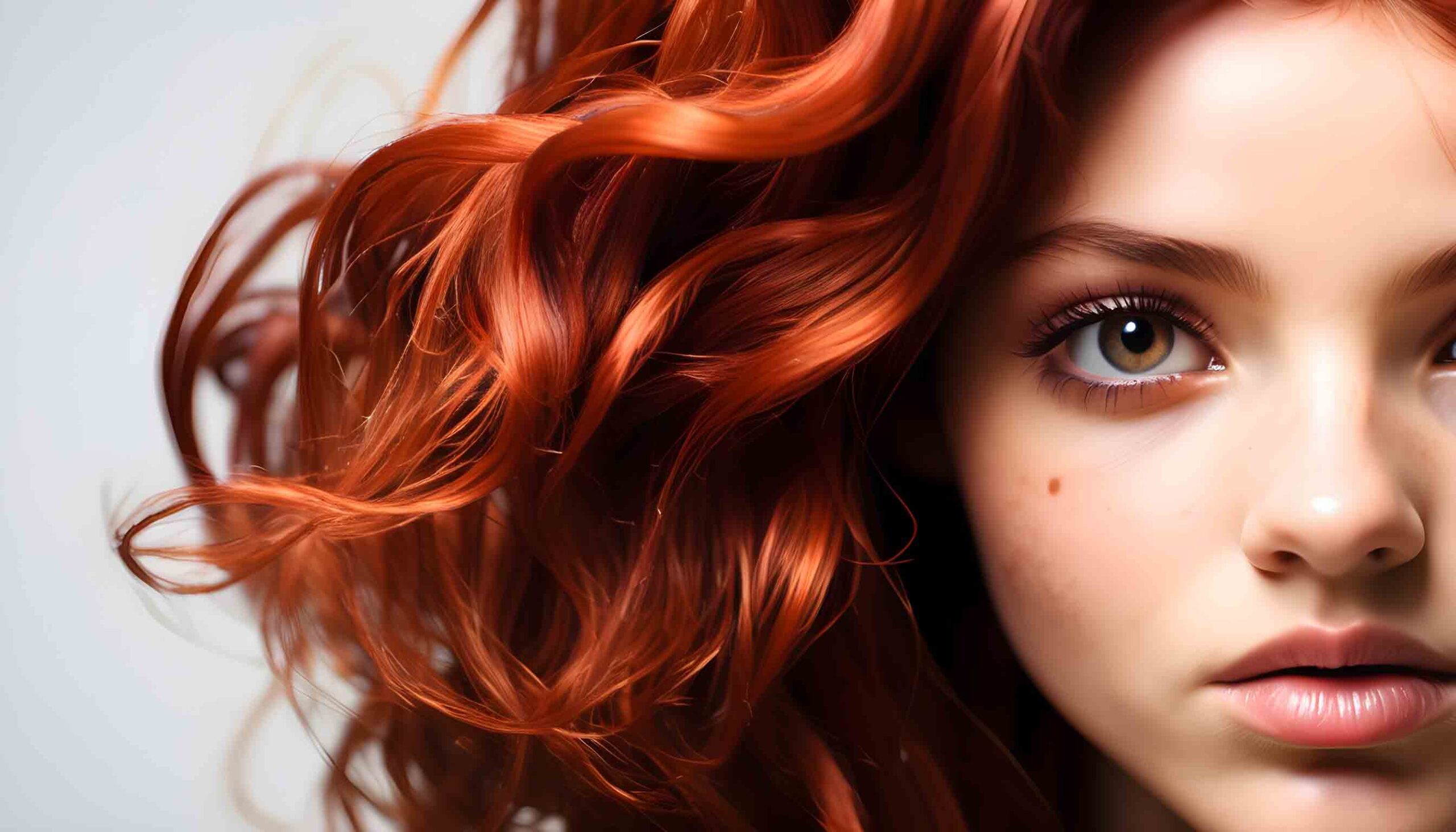Struggling with dry, frizzy hair? Learn how to smooth and define frizzy locks with tips for frizz-fighting shampoos, masks, heat protectants, oils, and anti-humectant serums. Discover the causes of frizz and how humidity, damage, and improper hair care create flyaways. Get advice for enhancing your routine to boost moisture, close the cuticle, and keep frizzy hair under control. From silk pillowcases to diffusers to avoiding brushing dry hair, find the ideal regimen for your hair type. Tame frizzy hair and embrace natural volume and movement with the right products and haircare techniques.
Frizzy Hair: Causes, Treatments, and Tips for Management
Frizzy hair is a common hair texture characterized by a lack of defined curl pattern, stand-away strand texture, and an overall dry, frizzy, and “poofy” appearance. While frizzy hair has no true curl pattern and lacks clumping or definition, it is frequently mistaken for curly hair. In reality, frizz occurs when the outer hair cuticle layer becomes raised, allowing moisture to escape and hair to become dehydrated. This causes strands to separate, creating a frizzy effect. With the right hair care routine and styling adjustments, it is possible to tame and manage frizz for smoother, more defined hair.
How to Stop Frizzy Hair
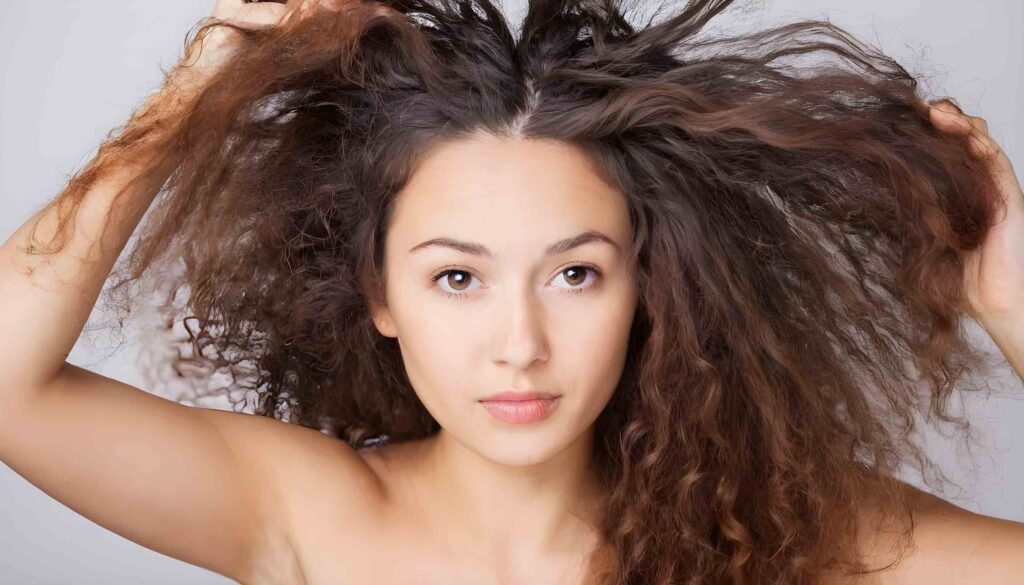
Frizzy hair occurs when the outer cuticle layer becomes raised, causing strands to separate and moisture to escape. This leaves hair dehydrated and undefined, resulting in a poofy, frizzy texture. To stop frizzy hair, focus on maintaining moisture balance in the hair strands.
Use hydrating shampoos and masks containing ingredients like coconut oil, shea butter, or argan oil. These nourish hair, smooth the cuticle and prevent frizz. After shampooing, apply a frizz-fighting serum or leave-in conditioner evenly from mid-shaft to ends to seal in moisture.
Limit heat styling, letting hair air dry whenever possible. When heat styling, always use a protectant spray or serum first. Sleep on a silk pillowcase, use soft scrunchies, and gently detangle only when hair is wet and conditioned. These haircare techniques minimize disruption to the cuticle layer and reduce frizz.
For quick frizz fixes, apply a few drops of smoothing oil like argan, coconut, or marula oil to the outer hair layer. Oils penetrate strands to moisturize and define texture. Or, make DIY frizz treatments like apple cider vinegar rinses or hydrating avocado hair masks. With the proper haircare regimen focused on moisture-boosting products and protective styling habits, it’s possible to smoothen and control frizzy hair.
Frizzy Hair Treatment
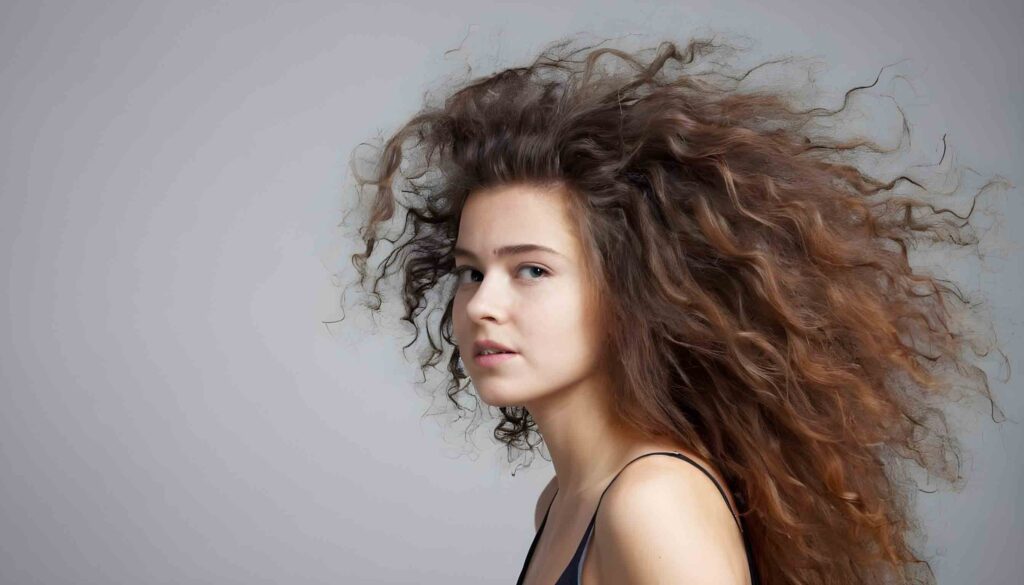
Frizzy hair lacks moisture, causing the outer cuticle to lift and strands to separate. Effective frizzy hair treatment focuses on hydrating and sealing the hair shaft.
Deep conditioning masks provide intensive moisture to smooth and define frizzy hair. Look for ingredients like shea butter, coconut oil, argan oil, honey, and avocado. Apply generously to damp hair and leave on for 30 minutes up to overnight, using heat if possible.
Anti-humectant serums coat the hair shaft to seal in moisture and prevent frizz. Silicones like dimethicone provide a protective barrier while oils like argan and coconut oil nourish hair and tame flyaways. Apply a few drops to wet hair before heat styling.
Natural oils also make excellent frizz treatments. Try rubbing coconut, olive, grapeseed, or marula oil over damp hair to hydrate and control frizz. For added nourishment, make a hair mask using mashed avocado or banana, egg yolk, or honey.
An apple cider vinegar rinse can help close cuticles and restore pH balance in hair, minimizing frizz. Add 1 tablespoon ACV to 1 cup water and pour over hair after shampooing. Limiting wash days, using lukewarm water, gently detangling, and protective styles like braids or buns also help maintain moisture and treat frizzy hair.
Hair Serum for Frizzy Hair
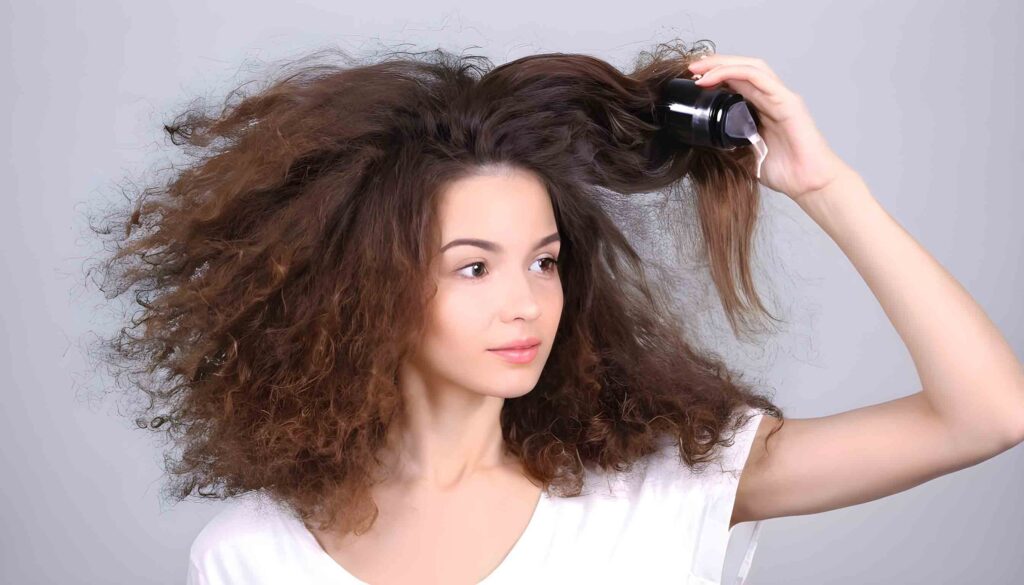
Hair serums can be extremely effective for taming frizzy, flyaway hair. Serums containing silicones like dimethicone and amino silicones coat the outer cuticle to seal in moisture and provide frizz control. Natural oils like argan, coconut, and marula oil also penetrate the hair shaft to condition, soften, and smooth frizzy strands.
Apply an anti-frizz serum or oil to clean, damp hair before blow drying or heat styling. This protects from heat and prevents frizz from forming. Use just a few drops, focusing on mid-lengths and ends. Avoid getting serum near the roots, as this can make hair appear greasy.
Lightweight serums containing hydrating oils work best for finer frizzy hair types. Look for argan, grapeseed, or coconut oil. Heavier oils like castor may weigh down fine hair. For thick or coarse frizzy hair, creamy serums with shea butter, aloe vera, or silicone provide extra frizz control.
DIY hair serums can also be made using natural oils like coconut, olive, almond, or avocado oil. For added nourishment, make a smoothing hair serum combining aloe vera gel with several drops of your preferred oil. Use sparingly and apply to damp frizzy areas. With the right anti-frizz serum used properly, it’s possible to achieve smoother, more defined frizzy hair.
How to Get Rid of Frizzy Hair
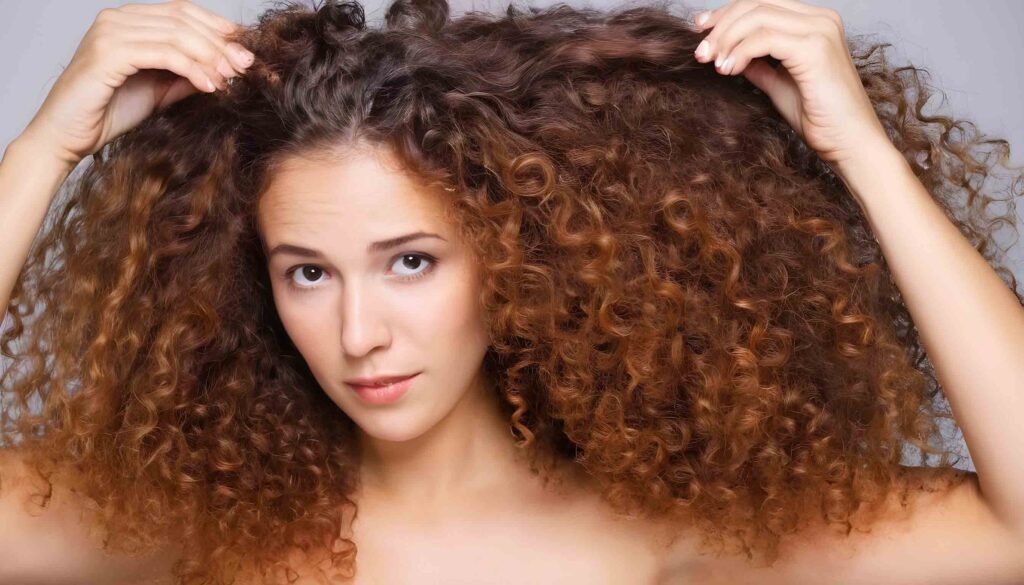
Frizzy hair occurs when the outer cuticle layer becomes raised, causing a lack of definition and moisture retention. To get rid of frizz, focus on smoothing the cuticle and hydrating hair.
Deep condition weekly using a hair mask containing nourishing oils and butter like coconut, shea, or argan. This hydrates hair and lays the cuticle flat. Detangle and style hair gently when wet, avoiding rough handling that can lift cuticles. Opt for loose braids, buns, or twists rather than rubbing with towels or brushes.
Use an anti-humectant serum or oil on clean, damp hair before blow drying or heat styling. This seals in moisture and provides protection. Try serums with silicones like dimethicone or natural oils like marula or grapeseed oil. Apply just a few drops to the mid-lengths and ends.
Let hair air dry instead of blow drying to minimize frizz. If heat styling, always use a protectant product first and keep tools moving. Ensure hair is getting enough protein by using a balancing shampoo and mask. This makes hair strands stronger and less prone to frizz.
Apple cider vinegar rinses can help close the cuticle. Add 1 tablespoon ACV to 1 cup water and pour over hair after shampooing. Limit shampooing, wash with lukewarm water, and sleep on a silk pillowcase. With the right combo of moisturizing products, gentle handling, and haircare habits, it’s possible to smooth and get rid of frizzy hair
Causes of Frizzy Hair
Several contributing factors can lead to frizzy hair:
High Humidity
Exposure to humid environments causes moisture in the air to be absorbed into hair strands. This makes the cuticles swell and stand away from the hair shaft, creating frizz. Those with naturally frizzy hair textures are most affected by high-humidity environments.
Hair Damage
Chemical treatments, heat styling, rough handling, and shampooing too frequently can all cause damage to the hair cuticle layer. This damage causes the cuticles to become lifted and frayed, making it easy for moisture to escape and frizz to occur.
Product Buildup
Buildup from hair products can coat the hair strands, disrupting the cuticle layer and causing frizz. Regular clarifying washes are important for frizzy hair types prone to buildup.
Improper Detangling
Aggressive brushing and detangling when hair is dry can cause mechanical damage. This lifts cuticles and worsens frizz and flyaways. Always detangle hair from the bottom up when wet and conditioned.
Weather Changes
Shifts between dry and humid weather can draw moisture in and out of the hair strand, causing the cuticle layer to swell and frizz to form. Those with naturally frizzy hair may struggle with the frizz levels fluctuating through different seasons.
How to Tame Frizzy Hair
Taming frizzy hair relies heavily on using the right hair care routine and styling techniques. Here are some of the most effective ways to smooth and define frizzy hair.
Invest in a Quality Blow Dryer
Using a diffuser attachment on a professional-grade blow dryer helps define curls and encourages clumping in frizzy hair. This increases smoothness and prevents frizz from forming during the styling process. A quality dryer helps shorten drying time, minimizing overall styling damage.
| Blow Dryer | Key Features |
|---|---|
| Dyson Supersonic Hair Dryer | Designed specifically for curly hair, the diffuser encourages curl formation, even heat distribution, cool shot button. |
| DevaCurl DevaDryer & Devafuser | Designed specifically for curly hair, diffuser encourages curl formation, even heat distribution, cool shot button. |
Style Hair When Wet
Styling hair when still dripping wet helps define curls and smooth frizz before drying. This allows you to shape hair accurately into place instead of wrestling with frizz once it is already dry.
Try a Silk Pillowcase
Cotton pillowcases can cause friction that lifts cuticles and worsens bedhead frizz. Switching to a smoother, silkier pillowcase minimizes friction and disruption to hair as you sleep.
Avoid Touching Hair Too Often
Excessive touching and rubbing of the hair, even when dry, can cause mechanical damage. Leave hair alone as it dries and resists playing with strands to minimize frizz.
Use Targeted Hairspray
Light-hold hairsprays can help tame flyaways and frizz for a smoother look. Focus spritzing on frizz-prone areas rather than all over.
Use Hand Lotion in a Pinch
If no frizz-taming products are available, rubbing a small amount of lotion between palms and then gently over the outer hair layer can help slick stray hairs. Focus mostly on flyaway areas rather than near the scalp.
Shampoo Less Often
Washing hair too frequently, even with sulfate-free shampoos, can strip needed hydration from strands and worsen frizz over time. Limit washes to 1-2 times weekly if possible.
| Shampoo | Key Features |
|---|---|
| Briogeo Curl Charisma Rice Amino + Avocado Hydrating Shampoo | Sulfate-free and containing frizz-fighting rice water complex, avocado oil adds moisture and cleanses hair gently without stripping. |
| DevaCurl Low-Poo Delight Weightless Waves Shampoo | Sulfate-free and contains frizz-fighting rice water complex, avocado oil adds moisture and cleanses hair gently without stripping. |
Swap Regular Towels for Microfiber
Rough, standard towels can create friction that disrupts cuticles. Instead, use an ultra-soft microfiber towel and gently squeeze your hair dry, don’t rub. This minimizes frizz and preserves the definition as hair dries.
Use Products Strategically
Lightweight frizz-fighting serums, mousse, and creams can be applied to damp hair and target the most frizz-prone areas. Avoid applying products near the scalp or hair roots.
| Product | When to Apply |
|---|---|
| Leave-in conditioner | After washing, apply evenly to damp hair |
| Curl cream | After leave-in, smooth over hair and scrunch |
| Mousse | After leave-in, foam in palms then scrunch into hair |
| Anti-frizz serum | Apply sparingly to frizzy areas before heat styling |
Heat Style Carefully
Allow hair to air dry as much as possible before finishing with heated tools. Always use protectants, avoid excessive direct heat, and keep tools moving to minimize frizz and damage.
Use a Diffuser Attachment
Diffusing helps encourage curl formation and minimizes frizz. Use a diffuser on low heat and low speed, allowing hair to air dry partially before finishing with the dryer.
Don’t Fight the Frizz
Some frizz is inevitable with this hair texture. Allow hair to air dry naturally when possible and learn techniques like scrunching to encourage definition. Embrace the volume and movement frizzy hair naturally has.
Go Easy With Products
Using too many heavy creams and oils can lead to buildup, clogged follicles, and worsened frizz over time. Find a simple routine using sulfate-free, lightweight products.
Cutting and Styling Tips for Frizzy Hair
In addition to product use and drying techniques, getting the right haircut and style can make a difference in frizz management.
Start With a Good Haircut
Ask your stylist for layers, face-framing highlights, and texturizing techniques like point cutting to encourage movement and separation of strands. Avoid blunt, boxed cuts.
Style With Braids, Twists, Buns
Low manipulation styles like braids, buns, and twists encourage hair to clump together rather than frizz. Use styling creams first to help slick hair smooth.
Create Loose Waves
Using a large barrel curling iron, curl hair in large, loose waves rather than tight curls. Gently break waves apart after cooling. This encourages a tousled look with minimized frizz.
Try Flexi Rod Sets
Flexi rods give a defined curly look when used on damp frizzy hair. Apply styler first then wind hair around rods, removing after fully dry.
Best Products for Fighting Frizz
Using targeted products for frizzy hair makes a significant difference in managing frizz. Here are some of the best options:
1. Frizz-Fighting Shampoos
| Shampoo | Key Benefits |
|---|---|
| Moroccanoil Smoothing Shampoo | Gently cleanses while infusing hair with hydrating argan oil |
| Alterna Caviar Anti-Frizz Shampoo | Sulfate-free formula with anti-frizz technology |
| Living Proof No Frizz Shampoo | Silicone-free shampoo that smooths without buildup |
2. Deep Conditioning Masks
| Hair Mask | Key Benefits |
|---|---|
| SheaMoisture Manuka Honey & Mafura Oil Intensive Hydration Masque | Hydrates and softens hair while reducing frizz |
| Briogeo Don’t Despair, Repair! Deep Conditioning Mask | Nourishes dry, frizzy hair and strengthens strands |
| Verb Hydrating Mask | Contains moringa oil to restore moisture and smooth frizz |
3. Heat Protectants
| Product | Key Benefits |
|---|---|
| An affordable option that helps minimize heat damage | Affordable option that helps minimize heat damage |
| Kenra Platinum Blow-Dry Spray | Protects up to 428°F while smoothing and frizz control |
| Verb Ghost Oil | Smooths frizz and flyaways while providing heat protection |
4. Frizz-Fighting Oils and Serums
| Product | Key Benefits |
|---|---|
| Moroccanoil Frizz Control | Argan oil smooths frizz and leaves hair silky |
| John Frieda Frizz Ease Serum | Smooths and straightens hair while blocking humidity |
| Verb Ghost Oil | Weightless formula to smooth frizz and flyaways |
Home Remedies for Frizzy Hair
Natural ingredients from your kitchen can also help fight frizz. Try these DIY treatments:
Apple Cider Vinegar Rinse
The acetic acid in ACV helps close cuticles and restore pH balance. Add 1 tbsp ACV to 1 cup water. Rinse hair after shampooing.
Coconut Oil Mask
Coconut oil penetrates hair to provide hydration. Apply warmed oil on damp hair. Leave on 30 mins then shampoo out.
Avocado Hair Mask
Mashed avocado contains fatty acids to moisturize hair. Combine with banana or honey. Leave on hair 30 minutes before rinsing.
Argan Oil
Argan oil is lightweight and quick-absorbing to smooth frizz caused by dryness. Apply a few drops to damp hair avoiding the scalp.
Egg Yolk Conditioner
Egg yolks contain protein to strengthen hair and reduce frizz. Whisk an egg yolk and massage it into the hair. Rinse after 20 minutes.
Tips to Prevent Frizzy Hair
Practicing good daily hair care habits helps minimize frizz:
- Know your hair’s porosity and moisture needs
- Shampoo less frequently
- Use lukewarm water when washing and rinsing hair
- Apply moisturizing hair masks weekly
- Allow hair to air dry naturally when possible
- Sleep on a silk pillowcase
- Avoid rubbing wet hair with towels
- Use soft, seamless hair ties and scrunchies
- Apply hair oil or serum if the hair is exposed to humidity
Frequently Asked Questions about Frizzy Hair
Here are answers to some common questions about frizzy hair causes, treatments, and management:
How do you get rid of frizzy hair?
Using hydrating shampoos and deep conditioners, limiting heat styling, air drying instead of blow drying, and strategic use of anti-frizz products can help smooth and minimize frizzy hair over time. A hydrating haircut with layers and face-framing pieces also helps manage frizz.
What causes frizzy hair?
Frizzy hair is primarily caused by a lack of moisture in the hair strand, which causes the outer cuticle layer to lift and become disrupted. Contributing factors like humidity, heat damage, chemical treatments, poor hair care practices, and genetics can worsen frizz.
How do you heal frizzy hair?
Focus on hair treatments that replenish moisture and smooth the outer cuticle, such as deep conditioning masks and oils. Reduce sources of damage like heat styling and brushing hair when dry. Ensure hair is getting the proper protein-moisture balance. Trim ends regularly to remove split ends.
What is the best treatment for frizzy hair?
Using hydrating shampoos and masks that contain oils or humectants can help smooth cuticles and hydrate frizzy hair. Anti-humectant serums and frizz-fighting oils with ingredients like argan oil or silicones can also temporarily tame frizz. Avoid heavy products that further weigh hair down.
How can I stop my hair from being so frizzy?
Limit shampooing, gently detangle hair when wet and conditioned, allow air drying when possible, sleep on a silk pillowcase, use soft hair ties, apply oil or serum to damp hair, avoid rubbing wet hair with towels, and minimize heat styling to prevent frizz.
How can I reduce frizzy hair naturally?
Apply natural oils like coconut, argan, or olive oil to damp hair to increase hydration and smoothness. Make DIY hydrating hair masks using avocado, banana, honey, or eggs. Create an apple cider vinegar rinse to close the cuticles. Use protective styles like braids, buns, or twists.
What causes frizzy hair?
Lack of moisture in the hair strand is the main cause of frizzy hair. Humidity, harsh shampoos, heat damage, rough handling, and certain hair textures are also contributing factors. The hair cuticle layer becomes raised and hair loses hydration, leading to frizzy, undefined strands.
How do you repair frizzy hair?
Repair frizzy hair with hydrating shampoos, masks, oils, and serums that smooth the cuticle. Reduce heat styling, brushing when dry, shampooing too often, and other sources of damage. Get regular trims to remove split ends. Evaluate your hair’s protein and moisture balance.
What is the best treatment for frizzy hair?
Deep conditioning masks, leave-in treatments, anti-humectant serums, blow drying with a diffuser, and strategic use of anti-frizz products work best. Look for ingredients like argan oil, coconut oil, silicones, shea butter, and avocado oil when treating frizzy hair. Avoid overusing heavy products.
How do you fix frizzy hair naturally?
Some natural ways to fix frizzy hair include using apple cider vinegar rinses to smooth the cuticle, applying coconut oil or argan oil to damp hair, making a hydrating mask from mashed avocado or banana, and doing an egg yolk hair treatment. You can also prevent frizz by limiting shampooing, avoiding heat styling, sleeping on a silk pillowcase, and letting hair air dry.
How do you treat extremely dry frizzy hair?
For extremely dry, frizzy hair focus on intensive weekly conditioning treatments. Use a hydrating mask for 30+ minutes with heat, or overnight. Look for ingredients like shea butter, honey, coconut oil, olive oil, or avocado. Shampoo less often and use conditioning shampoos and co-washes. Apply a serum or oil to damp hair. Limit heat styling.
Which is the best serum frizzy hair?
Some top-rated serums for frizzy hair include Olaplex No.7 Bonding Oil, Moroccanoil Treatment Original, Verb Ghost Oil, Briogeo Farewell Frizz Oil, Amika Blockade Heat Defense Serum, Alterna Caviar Anti-Frizz Serum, and Redken Frizz Dismiss. Look for lightweight silicones or oils like argan that won’t further weigh hair down.
Which natural hair serum is best frizzy hair?
For natural hair serums, try using coconut oil, argan oil, marula oil, grapeseed oil, or aloe vera gel. Apply a few drops to clean, damp hair while styling to smooth and tame frizz. You can also find natural hair serums with plant oils like Carol’s Daughter Goddess Strength Divine Strength Leave-In Cream.
Which serum is best frizzy hair in Pakistan?
Some top anti-frizz hair serums available in Pakistan include L’Oreal Paris Elvive Extraordinary Oil Serum, Schwarzkopf Osis+ Frizz Control Serum, Dove Hair Therapy Frizz Control Serum, Pantene Pro-V Frizzy to Smooth Serum, and EleGANTé Revolutionary Smoothing Serum. Local hair oil brands like Sunsilk, Pantene, and Dabur Vatika also offer frizz-control oils and serums.
Does hair serum work for frizzy hair?
Yes, hair serums can be very effective for controlling frizzy hair when used properly. Silicone-based serums coat the outer hair strand to seal in moisture and smooth down the cuticle layer. Oils like argan and coconut oil also penetrate the hair to condition and soften frizz. Apply serums or oils to towel-dried hair before blow drying or heat styling for best frizz reduction. Use them sparingly, focusing only on the mid-lengths and ends.
Conclusion
While frizzy hair can be difficult to control, having the right haircare routine and using targeted frizz-fighting products makes smoother, more defined hair possible. Focus on keeping hair adequately hydrated through shampoos, conditioners, masks, oils, and serums. Protect hair from damage, handle gently, and utilize drying and styling techniques to enhance definition. Embrace frizzy hair’s natural volume and movement, and learn how to manage it for your hair type and lifestyle. With patience and consistency using the right customized haircare regime, it is possible to tame and smooth unruly frizzy hair.


